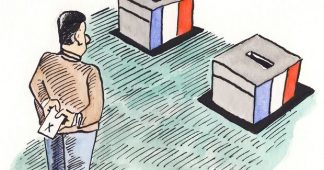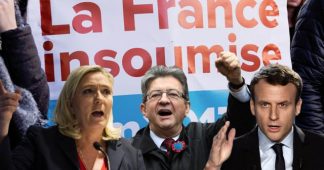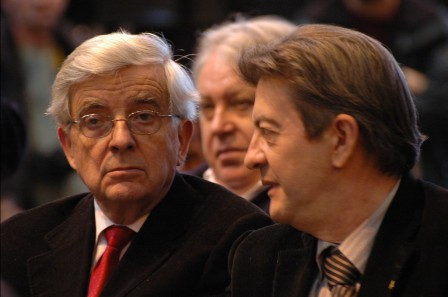The French left shouldn’t rest easy — Marine Le Pen hasn’t been vanquished.
By Sylvain Laurens
Sixty-six percent to 34 percent.
It sounded like a crushing victory for France’s Emmanuel Macron, who will now become the eighth president of the Fifth Republic. From abroad, this margin was welcomed very positively. It seemed like a resounding result, signaling that a large majority of French people had sidelined the racist political program embodied by Marine Le Pen. She would be no French Trump.
According to this narrative, the nationalist regression supported by part of the popular classes could not achieve a majority in France, where voters instead preferred a young president, liberal in his values as in his economic policies. Seen from afar, this landscape may seem reassuring for observers. Yet seen from up close, things are far less simple — or as positive for France and left-wing forces.
Le Pen’s Three Million New Votes
Marine Le Pen and her National Front (FN) did, of course, lose the election, but between the presidential election’s two rounds they won at least two battles.
Firstly, following the first round, Le Pen secured the backing of Nicolas Dupont-Aignan, formerly a leading figure in the Union for a Popular Movement (UMP, the classic right party). For some years he had embodied a sovereigntist right that was more respectable than the National Front in the eyes of right-wing voters. More reassuring than the heirs of the Le Pen family, Dupont-Aignan embodied a Gaullist sovereigntist right that made the European question an important point of division from the classic, governmental right. His “Debout la France” (“France Arise!”) movement had achieved good results in recent regional elections.
As soon as Dupont-Aignan’s support for Le Pen had been officially sealed, she presented him as her prime minister should she win the election. This presidential ticket was something new for the National Front, which had never before managed to establish alliances with political representatives of the classic right. Indeed, it was in a dispute over this same question of allying with the Right that Jean-Marie Le Pen, Marine’s father and the FN’s founder, had excluded Bruno Mégret and various cadres from the party in 1998.
Here, Marine Le Pen has harvested the fruits of her new political stance, and will have done something to reassure voters in the classic right camp who are disillusioned with the pro-European line of the conservative party Les Républicains.
Secondly, even if we add Dupont-Aignan’s first-round voters to Le Pen’s (and in fact only about half of them did follow his call to vote for her), we see that Le Pen must have gained an additional 1.2 million votes somewhere else between the election’s two rounds (Le Pen secured 10,644,000 votes in the second round, having obtained 7,678,000 in the first; Dupont-Aignan got 1,695,000 votes). Indeed, she made a real breakthrough among former prime minister François Fillon’s voters.
This advance was largely overlooked by pro-Macron editorial writers, who instead spent their time stigmatizing supporters of the left-wing Jean Luc Mélenchon/ France Insoumise, even though ultimately only 7 percent of them opted for Le Pen in the second round. Clearly, Le Pen’s progress was largely attributable to the conservative Fillon voters disappointed by the elimination of their candidate after the first round. Among the electorate who voted for Fillon in the first round, 48 percent chose to vote Macron in the second round. But 20 percent of them voted for Marine Le Pen, and 32 percent refused to vote or made a blank vote.
In summary, 52 percent of the classic right’s electorate refused the traditional republican front: they either voted for Le Pen or refused to vote for Macron.
This represents a significant development for France. The right-wing electorate had seemed relatively captive, and difficult to tear away from the conservative party (successively known as the Rally for the Republic [RPR], UMP, and now the Les Républicains).
The narrative of the angry working-class Mélenchon electorate voting indifferently for Left and Right does not hold water when we look at the statistics. The real novelty of the second round was the fact that a good share of right-wing voters chose Le Pen or abstention over Macron, French president François Hollande’s former finance minister.
Macron had made numerous pledges of his compatibility with the classic right (indeed, even before the first round many former ministers of the Right such as Dominique de Villepin and Alain Madelin had supported his candidacy). He had also paid a visit to Philippe de Villiers (a well-known figure in royalist circles) and given an interview to Causeur magazine, a very widely read publication on the far right.
But a major share of the right-wing electorate preferred to opt for the National Front rather than to follow their leaders’ call to vote for Macron.
A Radicalized Right
We can only understand Le Pen’s progress if we take seriously a striking fact of Hollande’s term: namely, that part of the Right’s traditional voters have been radicalized and are no longer bound by the voting instructions given by the Gaullist party’s leaders.
Even Fillon’s victory in the right-wing primaries was not the victory of a classic right-wing candidate. Fillon had appeared to many commentators as the man who served as a discreet prime minister under former president Nicolas Sarkozy. But in order to construct a political space of his own, in the primary contest against Sarkozy, he largely drew on the most radical fringe of the right-wing electorate. Supported by Sens commun (a Catholic-right tendency) and the movements emerging from the Manif pour tous (the Catholic-fundamentalist movements opposed to gay marriage), Fillon’s victory itself pointed to a very moralizing and very conservative movement ascendant within the classic right.
Forty-four percent of regularly practicing Catholics voted for Fillon in the first round. When it was revealed that Fillon had employed his wife and his family at the National Assembly using public funds, this electorate — very sensitive to positions on abortion or gay marriage — supported Fillon’s candidate anyway, strongly opposing his replacement by former prime minister Alain Juppé (who represented an opening to the center-right). They directly attacked Juppé’s supporters with verbal abuse and physical threats.
This was itself an index of the fact that part of Les Républicains’ voters rejected a centrist repositioning similar to Macron’s. As a recent survey of National Front voters indicates, the party’s current breakthrough is not necessarily coming from workers (for only one worker in seven voted for the National Front in the last regional elections, and many change their vote from one election to the next). The FN is consolidating its roots among a classic right-wing electorate and the upper reaches of society, who display more regular political involvement and greater continuity in their voting patterns.
The far right’s plushest neighborhoods are doing well. Indeed, Le Pen was the presidential candidate who had the highest level of nominations from representatives whose surnames included nobiliary particles (who may, therefore, potentially have been nobles). This point is difficult to see if we limit ourselves to data from polling firms, which often conflate very different electorates.
Another bright spot for Le Pen is that she ran relatively well among the younger electorate. Only 61 percent of the people who voted for Le Pen in the first round had done so in 2012. Another 15 percent had voted for Sarkozy, but most important were the large share of first-time voters. Eighteen to twenty-four year olds olds (a good proportion of whom had not voted in the previous presidential contests, because they were too young) represented 10 percent of Marine Le Pen’s electorate. Twenty-six percent of her voters were under thirty-four years old, as against only thirteen percent of Fillon’s.
This means that many young conservative voters’ first presidential vote was for the National Front. It is probable that among these there are a lot of precarious young people living in peri-urban contexts or in medium-sized towns. The correlation between poverty and the FN vote or unemployment and the FN vote cannot be seen in all towns, but it remains an important explanatory factor, as does the presence or absence of public services close to voters’ place of residence. There, Le Pen has the possibility of piecing together a new electorate, and indeed to do so in the long term. This is troubling for the leaders of the classic right.
A final development is that the FN enjoys new levels of support internationally. Previously, the FN had been happy to draw such support from former cadres of the far-right Italian Social Movement or the European far right. Her reception by Vladimir Putin on March 24 and above all the explicit support of part of the Trump administration were a real novelty, in this regard.
The National Front has managed to claim its place within the international networks that identify with the “alt-right,” networks that have impressive activist resources. Proof of this came in the form of the “MacronLeaks,” opportunely put into circulation a few hours before the second-round vote. The proliferation of fake news via party cadres’ Twitter accounts or during the TV debate also bore witness to a transformation in the FN’s modus operandi.
Faced with these developments, left-wing forces are extremely divided, even as the double breakthrough of Le Pen and Macron demands a rapid recomposition.
More Divided Than Ever
Macron’s campaign was waged at breakneck speed by a section of the liberal think tanks (the Institut Montaigne in the lead) and top functionaries at Bercy (the finance ministry). It very quickly divided the traditional left-wing electorate. If it was to work, it also had to significantly disorganize the Socialist Party (PS).
Macron and his supporters proved able to expertly steal a march on Prime Minister Manuel Valls and then to take advantage of the results of the Socialist primaries, which saw the triumph of the left wing of that party. With Benoît Hamon eliminating Valls in the primaries, activists on the left of the Socialist Party thought that they could now count on the party machine. But the existence of Macron’s candidacy offered an escape route for the whole liberal wing of the party, Valls in the lead.
In a situation that can be compared to that of Jeremy Corbyn in the UK Labour Party, Hamon thought he could hold back the defections. But Macron’s team was able to win over their support, to the great displeasure of activists further to the left of the PS, many of whom were left disgusted by the election. Twenty-seven percent of Hamon’s supporters preferred not to vote for Macron in the second round; forty-three percent of all of Macron’s voters in the second round did so in order to block Le Pen.
This dislocation of the PS left a space wide open for Mélenchon in the presidential contest. But will this space survive?
Running a campaign that was much less markedly left-wing than his 2012 candidacy in political terms (the red flags of last time now replaced by tricolors), and distancing himself from his alliance with the Communist Party, Mélenchon made a real electoral breakthrough, bringing to the polling booths voters who had hitherto abstained. But it will now be difficult for him to consolidate this political space.
On the one hand, once Macron is president he will be able to rely on a partial recomposition of the PS; on the other hand, as France Insoumise increasingly transforms into a party it will enter into competition with the Communist Party. This risks depriving it of an activist base that did campaign for Mélenchon, however willingly or unwillingly.
Will Mélenchon be able to build a new political force? France Insoumise is structured in a very particular way: a core of cadres providing direction from a distance, via the Internet, to supporters who have often been spontaneously recruited online. Of the expected candidates representing France Insoumise in the legislative elections, there are some who are truly new to politics and who have had little training.
Meanwhile, a lot of the Communists’ candidates are party old-timers, very many of whom have distinguished themselves by their support for the PS in past political sequences. The bloc of militants extending from the left wing of the PS to the Communist Party, passing via France Insoumise, is deeply divided. The parliamentary elections risk being a fiasco.
As for the trade unions, the elections have also left deep scars. Fifty-one percent of voters organized in the radical CGT voted for Mélenchon, as against 15 percent for Hamon and just 13 percent for the National Front. In the more moderate Force Ouvrière, one in three voted for Mélenchon, but there were also the 24 percent who voted for Le Pen. In the CFDT (a reformist union that placed first among all of France’s unions in the recent workplace elections), there was a plurality of support for Macron, with 48 percent of its members even voting for the new president in the first round. We can say the same of UNSA, a primarily white-collar union where close to 42 percent voted for Macron.
A unitary trade-union front opposed to Macron’s proposed labor reforms — one extending beyond the CGT/SUD alliance we already saw in opposition to Hollande’s labor reforms — seems rather unlikely.
For all these reasons, Le Pen’s defeat in the second round of the presidential election is without a doubt no more than a transitional moment between two states of the French political landscape. While some may hope that the National Front will splinter thanks to its internal divisions, Le Pen now commands major resources for bringing into being an openly nationalist and racist party that transcends the limits of the space that the FN previously occupied. Left-wing forces have to take seriously the appeal Le Pen made on the evening of the second round, calling for the creation of a new party.
Faced with the emergence of an alt-right à la française, Macron has proposed a single ultra-liberal formation comprised of the greater part of the figures of both left- and right-wing parties who have governed up until now. Faced with these two blocs — the one fascist, the other ultra-liberal — the emergence of a third force seems uncertain for the moment.











